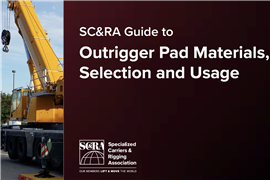Loader cranes: new and renew
18 May 2016

Interesting developments in the articulating or knuckle boom crane sector in the last year range from entire new crane ranges to some more detailed technical innovations. Alex Dahm reports
As seems to be the case most years, we have an impressive number of new cranes to write about this time around. Manufacturers Hyva and HMF, to name two, have entire new ranges or families of models. From other manufacturers range-topping models have been added that increase capacity and capability.
Environmental concerns are being addressed with the introduction of battery-electric and hybrid power options. Water-based hydraulic fluid has already been a feature available from some manufacturers for some time, as has water-based paint processes on the manufacturing side.
Also increasingly prevalent is the use of high strength steel which allows a lighter crane structure with attendant benefits in terms of smaller and lighter components which mean less overall weight in the crane, leaving more for payload and-or lower fuel consumption for the truck or other carrier vehicle. Fassi’s new F65B and F70B use of high strength steel has reduced weight by 9 % over the previous model, the Italian manufacturer says.
Customer specifications for loader cranes change little from one year to the next but their expectations are always for more reach, more power, less weight, and greater uptime, says Alan Johnson, sales director at Danish manufacturer HMF in the UK. Linked to the last point is a growing requirement for flexibility of servicing. “Uptime is a major consideration and servicing ‘out of hours’ and at different locations when the chassis is being serviced is a major consideration for operators as it allows them to utilise the vehicle to its fullest,” Johnson explains.
Consideration of this is now being made in the design of new loader cranes. “We have recently made components modular to allow greater flexibility on maintenance, along with our design concept of placing components internally, affords them greater protection,” Johnson continues.
Again linked to the above is software and the recording of operational data, lifetime cycles, and setting servicing intervals and other requirements. Oil sampling for preventive maintenance in line with use and ensuring we get the most out of all the consumables is a key factor.
New series
Hyva has two new lines of hydraulic cranes in 12 models. The HT130 and HT162 are 13 and 16 tonne-metre class telescopic boom cranes for car recovery and in other applications where a compact, light and easy to operate crane is needed.
The 13 and 16 tonne-metre class HB130 and HB160 articulated boom cranes are also new. The HC131, HC143, HC153, HC161, HC171 and HC183 are 13 to 18 tonne-metre-rated models with a double linkage boom system. The HC131K and HC161K are13 and 16 tonne-metre class short boom articulated cranes with double linkages. More classes will be added to the new Hyva line over the next two to three years, extending the range to span 8 to 150 tonne-metres.
HMF categorises its product ranges in families as follows: Handy Range, Small Range, Mid Range and Large Range. Each takes it in turn to be fully redesigned in cycles. The manufacturer has just finished designing its new Small (4 to 8 tonne-metre) range due for deliveries to start in August. “It is a completely new design from scratch with some great features. Our core design criteria for this family is weight and it has an average weight saving of 30 % on the outgoing product, giving it a market leading power to weight ratio (kg of lift power to kg of steel construction),” Alan Johnson says.
One of two new series from market leader Palfinger is the Solid range which replaces the PK 16.001, PK 16.001-K and PK 18.001 EH models. The boom system can be ‘overstretched’ with a single “elbow lever”, known as the Single Link Plus. Solid models are offered in three configurations. The PK 17.001 SLD 1 is the non-CE entry level model without overload protection. The PK 17.001 SLD 3 has Paltronic 50 and is available in CE and non-CE versions. The top Solid version is the PK 19.001 SLD 5 with the addition of E-HPLS, radio remote control and a load-sensing control valve.
Also new from Palfinger is the Solid Compact series. The Single Link Plus means the PK 5.001 SLD 3, the PK 7.001 K SLD 3 and the PK 7.501 SLD 5 offer better movement geometry than previous models, the manufacturer says. With the PK 7.501K SLD 5 an HPLS version is offered in the 7 tonne-metre range for the first time.
More capacity
New from further up the capacity scale is the heavy duty Palfinger PK 165.002 TEC 7 designed for carrier vehicles with a maximum gross weight of 32 tonnes. It is 800 kg lighter than its predecessor, the PK 150.002, the manufacturer says.
Manufacturer MKG in Germany has added the 16.5 tonne HLK 801 HP to its heavy crane range. In addition to the conventional four outrigger support base, the new crane has an additional dual front support with a maximum permissible load of 13.5 tonnes. It helps maximise capacity through 360 degrees on a narrow outrigger spread of 8.61 metres, the manufacturer says.
With six extensions giving an hydraulic outreach of 16 m, plus a four extension hydraulic jib, maximum outreach is 24.75 m. The crane works with its continuously variable ACS 3 Stability System in conjunction with the new MKG ACS 3 Plus system. Sensors on the crane monitor the inclination of the vehicle in real time and allow optimum utilisation of the load capacity in relation to stability, the manufacturer says.
Also standard on the MKG is the ALG automatic load-dependent speed control. When lifting heavy loads, the system recognises the request and automatically switches to ALG mode, which reacts in proportion to the load. The ALG works to prevent dangerous load swing, to protect the crane from excessive stress on the structure and to reduce wear. Other features include continuous rotation, 15 degree fold-back on the boom, and double links for high capacity at short radius. An octagonal boom profile and pre-stressed sections mean less deflection under load which reduces wear, MKG says. A 3,900 kg winch is fitted.
Fassi from Italy has also been busy in product development. The new F2150RA/RAL has a maximum load moment rating of 136.4 tonne-metres and an hydraulic reach up to 41 metres with a jib. Its electronic and hydraulic equipment includes the FX800 control unit, D900 digital hydraulic distributor, RCH/RCS radio control, ADC automatic dynamic control, Flow sharing and the XP system.
Also new from Fassi is the F1650RA, created for challenging lifting jobs. It uses the Prolink system to give manoeuvrability in restricted spaces. Capacity is 130 tonnes and the maximum hydraulic reach is 41 metres with a jib. Three versions are available, with four, six and eight boom sections and five possible jib combinations.
The 53 tonne-metre Fassi F545RA xe-dynamic is new in the XE series between the larger F560RA he-dynamic and the smaller F485RA xe-dynamic, but with more performance and a better power-to-weight ratio. The footprint has been increased by just 85 mm over the F485RA model. It weighs 3 % more but is 10 % stronger thanks to stabilisers that extend to give a spread of 7.8 m. Maximum load moment is 53 tonne-metres (518 kNm) and hydraulic reach is 20.8 m.
Launched last year by Hiab were the X-HiPro 548, X-HiPro 638, and X-HiPro 658. They are designed to quickly lift heavy and bulky materials. Features include chain-driven stabiliser span, hydraulically tilting stabiliser legs and a quick to install jib. Marcel Boxem, Hiab director, heavy range, loader cranes, says, “These cranes are designed for performance. The new hydraulic and electronic systems make control of the cranes smoother, more accurate, and faster than ever before, and the new damping system creates a very stable, gentle performance when lifting. Our new control valve delivers much higher oil flows, which gives significant improvements in speed, and the new base design halves the time it takes to set the crane up for a lift.”
Back to Fassi and the new F305A and F255A in the mid-range. .The latter has a maximum load moment rating of 22 tonnes and a hydraulic reach of 17.1 m, increasing to 25 m in the version with four extension booms paired with the L213 hydraulic extension plus manual extensions. Versions are available up to a maximum of six hydraulic extension booms in the base configuration and in four versions with a short final section.
A new large construction crane from Atlas in Germany is the 206 VE which reaches 14.3 m and can lift a load of 1,160 kg when extended horizontally. At its shortest reach of 2.4 m it lifts 4,800 kg.
New from Italian manufacturer Effer is the 95 TLF, a model that will lift 18.9 tonnes at 4 metres radius. It is aimed at the Turkish market. Vertical reach with six extensions is 22 m and capacity at the maximum 18.9 m horizontal outreach is 3,680 kg. A version with a four section jib extends vertical reach to more than 34 metres and capacity at the maximum 31.7 m horizontal outreach is given as 790 kg. It can be mounted on a three axle truck, has a winch and operation is from a seat station that slews with the crane or via a hand-held belly box type radio remote control.
Smaller
New from Atlas in Germany is a 2.8 tonne capacity 66.3E, a 66 kN articulating crane with up to four hydraulic extensions and a reach of 11 metres.
Recent launches from Hiab include two new capacity classes in the renewed T-Series from 0.9 to 3.5 tonne-metres. The 0.95 tonne-metre T-009 is the smallest in the range and weighs just over 130 kg. The T-018 is a popular size for many applications and boasts easy mounting on pickups and light trucks. “The T-series features the latest technology such as nDurance, SmartControl and hybrid drive. They are light cranes with strong advantages,” says Patrik Kvarnlöf, director at light range - loader cranes, Hiab.
Technology
Hiab’s ePTO is an electro-hydraulic alternative to running the truck engine to drive the power take off and run the hydraulic pump to power the crane. It is quieter and there is no exhaust gas. The truck’s engine can be switched off and the PTO switches the hydraulic pump drive to an electric motor powered by lithium-ion batteries. The power requirement is up to 70 % less than for a conventional crane because the motor only runs the pump when a lever is actuated that demands it. There is no loss of capacity, Hiab says, and its 40 kW-hour battery should run a day of medium duty utilisation before needing to be recharged. A fast charge can be done in 1 to 1.5 hours to 80 % of capacity. A six hour or overnight charge is needed for 100 %. Pictured is a 19 tonne-metre crane and larger models, in the 22 to 25 tonne-metre range will be shown later in 2016.


